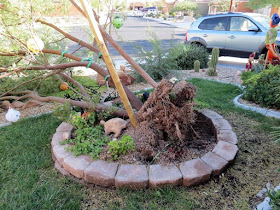 |
| One of the planters for a Chinese Pistache tree |
A. ‘Red Push’ Chinese Pistache tree can get 50 to 60 feet tall with irrigation. In my opinion, this tree is too tall for most residential properties. You need a large landscape, a park or city streetscape to accommodate that size.
Read what Chris Martin from ASU has to say about Chinese Pistache in the Phoenix area.
The size of the planters should not be a problem when planting Chinese Pistache if using a soil coarse textured enough for good drainage and not planting shallow rooted flowers in there that require frequent, light irrigation. If planting something else in that planter, select plants that have deep roots or that don’t require frequent irrigation.
I would select a smaller tree. I have the feeling you selected that tree because of its fall color. There are other reasons for tree selection than just one trait. What sizea tree is needed for those planters? 20 feet? 30 feet? Remember, larger trees usually use more water. What shape should it be? Arching? Round? Upright?
The Phoenix area has some pretty good wholesale nurseries that grow plants for the desert including Mountain States Nursery and Arid Zone Trees. Take a look at what they have to offer.










































